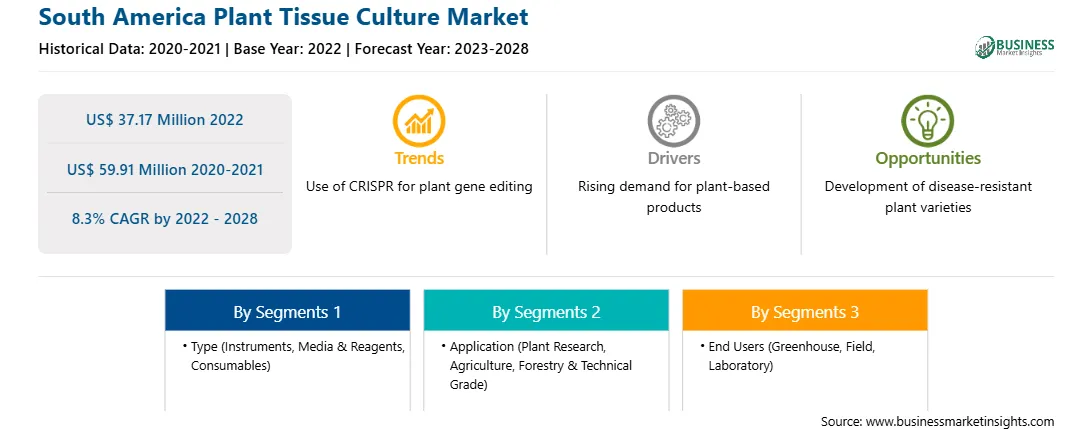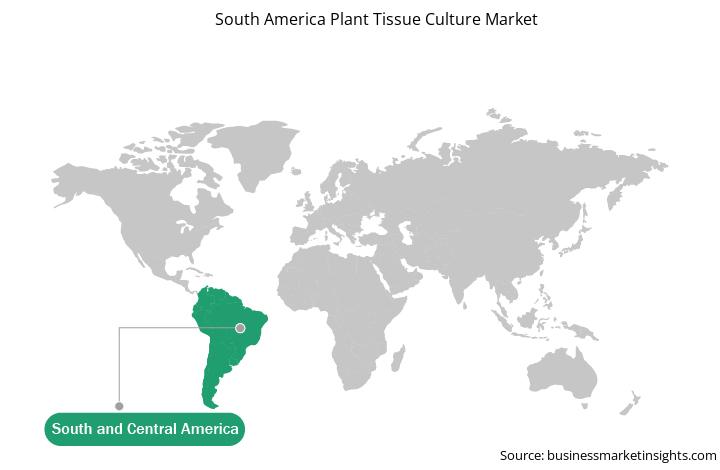南美洲植物组织培养市场预测至 2028 年 – COVID-19 影响和区域分析 – 按类型(仪器、培养基和试剂以及消耗品)、应用(植物研究、农业、林业和技术等级等)和最终用户(温室、田间和实验室)
No. of Pages: 111 | Report Code: BMIRE00027969 | Category: Life Sciences
No. of Pages: 111 | Report Code: BMIRE00027969 | Category: Life Sciences
组织培养实验室自动化促进市场增长
多个发展中国家已开展试管苗自动化技术和设备的研究。手工繁殖时,在子叶和茎之间的节点处抓取和切割植株,该位置很难定位,并且很容易被抓取器损坏。使用农业智能机器人代替人工操作,将显着提高苗木繁殖的效率和质量。与人工繁殖相比,使用机器人的污染机会更少。劳动力成本逐年增加。由于电子和机械技术的快速发展,在不久的将来,机器人机器的成本将会下降。因此,实验室正在引进机器人,以便正确执行程序并具有成本效益。重组蛋白表达的高通量筛选在早期工艺开发过程中是有利的,因为它可以确定最佳的表达构建体和工艺条件。基于微量滴定板的简单筛选平台可用于微生物和动物细胞,但这对于植物来说是不可能的,直到植物细胞包(PCP)(也称为“饼干”)的开发出现。为重组蛋白生产提供了多功能且可扩展的筛选工具。这将有助于根据研究人员的需要培育幼苗。由于机器人技术在植物组织培养实验室中的使用,植物组织培养市场预计将增长。
南美洲植物组织培养市场概况
南美洲植物组织培养市场分为巴西、阿根廷和南美洲。食品和饮料行业对水果和蔬菜成分的需求正在上升。南美洲的饮料行业,有助于该地区的市场增长。旅游业的扩张带动了南美洲酒店和餐饮业的发展,为水果和蔬菜创造了新的途径和需求。此外,由于健康意识不断增强,该地区的消费者更愿意将蔬菜和水果作为日常饮食的主要成分。因此,消费者对更健康和优质食品的偏好,例如用天然成分制成的冰沙、果汁和沙拉,扩大了南美洲对植物组织培养的需求。
南美植物组织培养市场细分
南美植物组织培养市场根据类型进行细分,应用程序、最终用户和国家/地区。根据类型,南美植物组织培养市场分为仪器、培养基和设备。试剂和耗材。仪器细分市场在2022年占据最大的市场份额。此外,仪器细分市场分为培养箱、离心机、显微镜、灭菌器等。同样,媒体和试剂分为murashige和skoog介质、linsmaier和skoog介质等。
根据应用,南美植物组织培养市场细分为植物研究、农业、林业和农业。技术等级等。 农业细分市场在 2022 年占据最大市场份额。
根据最终用户,南美工厂组织培养市场分为温室、田间和实验室。 田间细分市场在 2022 年占据最大的市场份额。
按国家/地区划分,南美植物组织文化市场分为巴西、阿根廷和南美洲其他地区。巴西将在 2022 年占据市场主导地位。
Thomas Scientific LLC;西格玛-奥德里奇有限责任公司; HiMedia 实验室私人有限公司;沉箱实验室公司;阿尔法实验室有限公司;和 Becton、Dickinson and Co. 是南美植物组织培养市场的领先公司。
Strategic insights for South America Plant Tissue Culture involve closely monitoring industry trends, consumer behaviours, and competitor actions to identify opportunities for growth. By leveraging data analytics, businesses can anticipate market shifts and make informed decisions that align with evolving customer needs. Understanding these dynamics helps companies adjust their strategies proactively, enhance customer engagement, and strengthen their competitive edge. Building strong relationships with stakeholders and staying agile in response to changes ensures long-term success in any market.

| Report Attribute | Details |
|---|---|
| Market size in 2022 | US$ 37.17 Million |
| Market Size by 2028 | US$ 59.91 Million |
| Global CAGR (2022 - 2028) | 8.3% |
| Historical Data | 2020-2021 |
| Forecast period | 2023-2028 |
| Segments Covered |
By 类型
|
| Regions and Countries Covered | 南美洲和中美洲
|
| Market leaders and key company profiles |
The regional scope of South America Plant Tissue Culture refers to the geographical area in which a business operates and competes. Understanding regional nuances, such as local consumer preferences, economic conditions, and regulatory environments, is crucial for tailoring strategies to specific markets. Businesses can expand their reach by identifying underserved regions or adapting their offerings to meet regional demands. A clear regional focus allows for more effective resource allocation, targeted marketing, and better positioning against local competitors, ultimately driving growth in those specific areas.

The South America Plant Tissue Culture Market is valued at US$ 37.17 Million in 2022, it is projected to reach US$ 59.91 Million by 2028.
As per our report South America Plant Tissue Culture Market, the market size is valued at US$ 37.17 Million in 2022, projecting it to reach US$ 59.91 Million by 2028. This translates to a CAGR of approximately 8.3% during the forecast period.
The South America Plant Tissue Culture Market report typically cover these key segments-
The historic period, base year, and forecast period can vary slightly depending on the specific market research report. However, for the South America Plant Tissue Culture Market report:
The South America Plant Tissue Culture Market is populated by several key players, each contributing to its growth and innovation. Some of the major players include:
The South America Plant Tissue Culture Market report is valuable for diverse stakeholders, including:
Essentially, anyone involved in or considering involvement in the South America Plant Tissue Culture Market value chain can benefit from the information contained in a comprehensive market report.